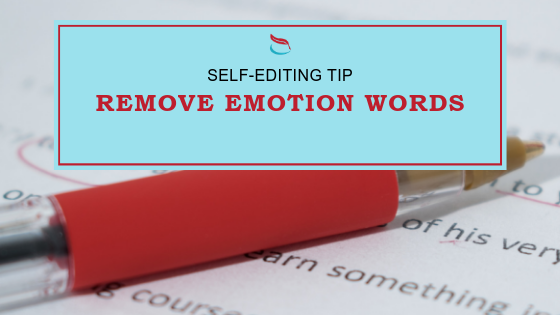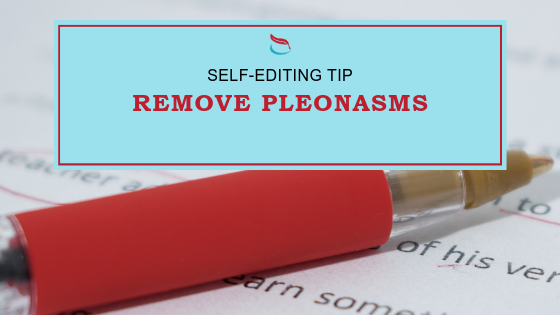|
Words. Removing emotion words, that is. She felt sad. He was angry. If you find you’ve written sentences like these in your manuscript, chances are good you have one of two problems:
It’s easy to write, “He seemed agitated.” It’s much harder to think about and write something like: His hands moved in a circuit from rubbing the back of his neck to pulling the collar of his shirt away from his throat to patting his right hip pocket. He flinched when the clerk asked for his order. It’s more interesting for us readers to experience your story by reading these descriptions; we lose that experience when you tell us someone is bored. We also get to know your character better when you show us how that character experiences boredom: one person may watch TV and eat a bag of chips; another may pace; and another may start picking at the loose threads on their sweater, slowly shredding it. And, bonus!, these descriptions give you something more to work with later in your story. Perhaps that empty chip bag becomes a clue to whodunnit. Maybe that shredded sweater was a gift from an ex-boyfriend who comes back seeking a reconciliation. When you come across emotion words in your manuscript, try deleting them. If the scene still shows the emotion, then you’re done. You didn’t need that crutch. If you’ve lost something by deleting that emotion word, work on rewriting the scene a bit to show the emotion. If you find you’re struggling with describing emotions, check out the Emotion Thesaurus. This book, written by writers for writers, lists 75-ish emotions and their definitions. The writers include both external (visible to an outsider) and internal (felt only by the person experiencing the emotion) signs that describe each emotion. When I'm doing the editing
1 Comment
What do these sentences have in common?
These sentences all use more words than are necessary to convey meaning. You can only nod your head,* and a nod only goes up and down. You can’t squint anything but your eyes, just as you can’t shrug anything but your shoulders. Ice is frozen; it’s always frozen. When ice isn’t frozen, it’s just … water. And when you kneel, you kneel down; you can’t kneel up! Adding those extra words creates a type of redundancy called pleonasm. As an editor, I also find those phrases pet peeves, and I kill them dead. See what I did there? “Kill them dead” is another pleonasm. You can’t kill something halfway. (I did the same thing in the title of this blog post.) Most pleonasms are stylistic errors, but you can use a pleonasm as a stylistic choice to add (poetic) emphasis: “I saw it with my own eyes.” Whose eyes? My OWN eyes! Some phrases, like “free gift” or “foreign imports” are used so often together that it can be hard to recognize that they contain redundancies. And some phrases, like "tuna fish" are idiomatic (in American English, at least), and so you can make a case that this instance is not a stylistic error. This list of 200 common redundancies in English can help you re-train your eye. When you spot pleonasms in your writing, it’s best to delete the redundancy, as many readers will consider it an error. Aside from that, deleting any redundancies just makes your writing tighter, which can help it become more powerful. And, if you’re focused on a tight word count, deleting redundancy is an easy way to start cutting. Alternatively, make very, very sure that you INTEND the redundancy because you want to emphasize the thing that is repeated. When I'm editing your work...
* OK, so it’s not entirely true that you can only nod your head. James S. A. Corey, in his series The Expanse, created a hand- and body-gesture-based language for people who work in bulky space suits. You can’t see someone nodding in a space suit, so in his world, spacers “nod their fist.”
Every character needs a description, but how do you include that description without stopping the story's flow? How do you include it without creating a situation that feels contrived? How often should you describe your characters? Read Beguilement by Lois McMaster Bujold and learn description techniques from a master. To describe or not to describeShould you describe your characters at all? Some writers believe that offering too much (or any) description of the main character distances readers from the story because then readers cannot simply picture themselves as the protagonist. Some writers want to control their world and characters and therefore want to describe those characters so completely they cannot be confused with anyone else. Ever. Either of these choices is reasonable (altho the second can easily become tedious). These choices are style issues: some readers want a lot of character description while others don't. You get to pick what you want to do. Repeat, repeat, repeatIf you decide to describe your characters, you must repeat that description throughout your story. Not as a solid block, but with key words placed strategically here and there to remind readers who they are reading about. Readers need these reminders because, while some will sit down to devour a book, most have to set it down to eat, sleep, do homework/laundry, go to school/work, and they will forget what the characters look like during their time away from the book. (Or worse, if they are like me and have two or three books going at once, a lack of description can make it harder to keep the separate story lines straight.) BEGUILEMENT and Fawn BluefieldBujold had some 14 published books under her belt before she wrote Beguilement, the first book in the Sharing Knife series, so she knows a thing or two about writing. She has a clear idea of what her characters look like and keeps offering up reminders for the reader. Fawn Bluefield, the book’s female protagonist, is described as short, with pale skin, dark curly hair, and big brown eyes. All those descriptions are offered up, again and again, in different ways and from different viewpoints. Character ThoughtsFrom Fawn’s point of view, we learn her appearance through her thoughts (and note the page numbers, to see how often the simple description of being short, or having curly hair, is repeated, and how late into the book it appears):
Character ActionsWe are also reminded of Fawn’s appearance through her actions:
Other Characters' ThoughtsWe see Fawn’s appearance through the eyes and actions of others, most often from Dag, a Lakewalker patroller who is essentially a foreigner in Fawn’s lands. Note again that these descriptions are consistent, and appear even very late in the book.
ComparisonsA good way to continue reminding readers of a character's description is to compare one character to another. With living characters, you can provide info about both characters with the description. With dead characters, you can give us description without being too contrived: She looked in the mirror and noticed her face now looked like her mother's. No wonder her father turned away from her. Note that this technique is almost common enough to be a cliché, or at least a trope (at least in the fantasy I've read), but it can be useful, especially if the comparison between two characters helps explain the relationship between two other characters.
Why did I read this book?Uh, ‘cause I just loves me some Bujold? Seriously, Lois McMaster Bujold is, like, my favorite author EVER and I reread her stuff with surprising regularity. Now to be honest, this isn’t my favorite Bujold book, and the first time I read it, I really didn’t enjoy it. I was reading it with the YA rules for new authors in mind: all first books in a series must satisfyingly end before the second book can start. This one doesn’t do that. It just stops, rather like the first part of a four-part book than a complete story in itself. When I read it a second time, as the first part, I liked it much, much better (tho the third book in the series is, in fact, my favorite). I started reading the series again because I wanted something familiar and comfortable. I had a sinus infection when I started re-reading these books and I just didn’t want to struggle with a new author/story while struggling with massive headaches. (Whine, sniffle, whine.) Beguilement, by Lois McMaster Bujold. Book 5/1000. About 1000 BooksReading widely changes your writing. For the better. Many published writers credit their success to having read voraciously, both in and out of their chosen genres. But most people don't read like editors; they read for enjoyment, not to learn a new writing technique. I read for a zillion reasons, and one IS to learn writing and story-telling techniques. Occasionally, I'll write about what I learn and share it with you here. Read 1000 books. Then write one. |
About ValI read, and then I tell you about what I've read. Whether you want to hear about it or not... Categories
All
Archives
July 2019
|











 RSS Feed
RSS Feed
